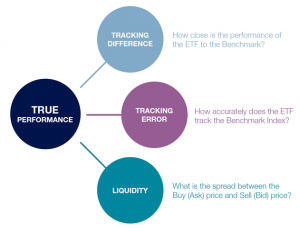Oct
2022
Investing Basics: Constructing a Portfolio of ETFs
DIY Investor
9 October 2022
Exchange Traded Funds, or ‘ETFs’ as they are known, are leading the charge in a new democratic world of investment where investors are increasingly taking charge of their own portfolio – writes Ben Thompson
Why? Firstly because they are simple to trade. Just like regular shares, ETFs can be purchased through a UK stock broker using a share dealing account, ISA or SIPP.
The second reason is diversification. ETFs are intrinsically diverse. For example, instead of building your own portfolio of UK equities, and paying costs and fees on each one, you can purchase a single ETF that provides exposure to the top 100 UK companies
through the FTSE 100 Index.
Not only are the vehicles themselves diverse, but with a product range spanning different market sectors, regions, themes, commodity baskets or fixed ncome strategies, and the whole risk spectrum from government bonds to single country emerging markets,ETF investors can easily create a well diversified core portfolio.
Furthermore, with both income paying (distributing) ETFs and growth (capitalising) ETFs available, they can capture both growth and income. ETFs can also be used tactically to take advantage of short term trends.
The combination of core and satellite allocations means that investors can build a portfolio to suit their specific views and investment budget. Small portfolios can be built with a handful of ETFs, and larger portfolios with very specific exposures can achieve even greater diversification.
The third major factor is cost. Unlike actively managed funds
where you are buying the skills of a ‘Manager’, with ETFs you are simply buying a passive investment that tracks a benchmark index.
As such, ETFs are significantly cheaper and Total Expense Ratios (TERs) typically range between 0.15% and 0.85% per year. This TER is the annual charge that includes costs such as custody fees, marketing costs and index licensing costs.
On top of this, investors will be charged a brokerage fee in the same way as when buying shares. Importantly though, the TER is not a true measure of the Total Cost of Ownership (TCO).
Although all ETFs share the same aim – to track an index as cost effectively and precisely as possible – some do it much better than others.
Tracking difference and tracking error are two measures that describe how precisely and consistently the ETF tracks its benchmark.
As anything less than the index performance is a cost to you, it is important to look at these variables.
The bid/ask spread will also impact performance as the difference between buy and sell price is key to your trading cost. As with any investment product, ETFs carry a number of risks.
Most ETFs are index tracking funds, meaning the performance of an ETF will rise and fall with the underlying index which may be complex and/or volatile, exposing investors to market risk. Investors’ capital is at risk, and you may not get back the amount originally invested.
Investors may be exposed to counterparty risk resulting from the use of securities lending in physical ETFs, or from the use of an OTC performance swap with an investment bank for synthetic ETFs.
If the index or theconstituents of the index are denominated in a currency different to that of the ETF, investors are exposed to currency risk from exchange rate fluctuations.
Commentary » Exchange traded products Commentary » Exchange traded products Latest » Financial Education » Latest » Pensions commentary » Uncategorized

Leave a Reply
You must be logged in to post a comment.